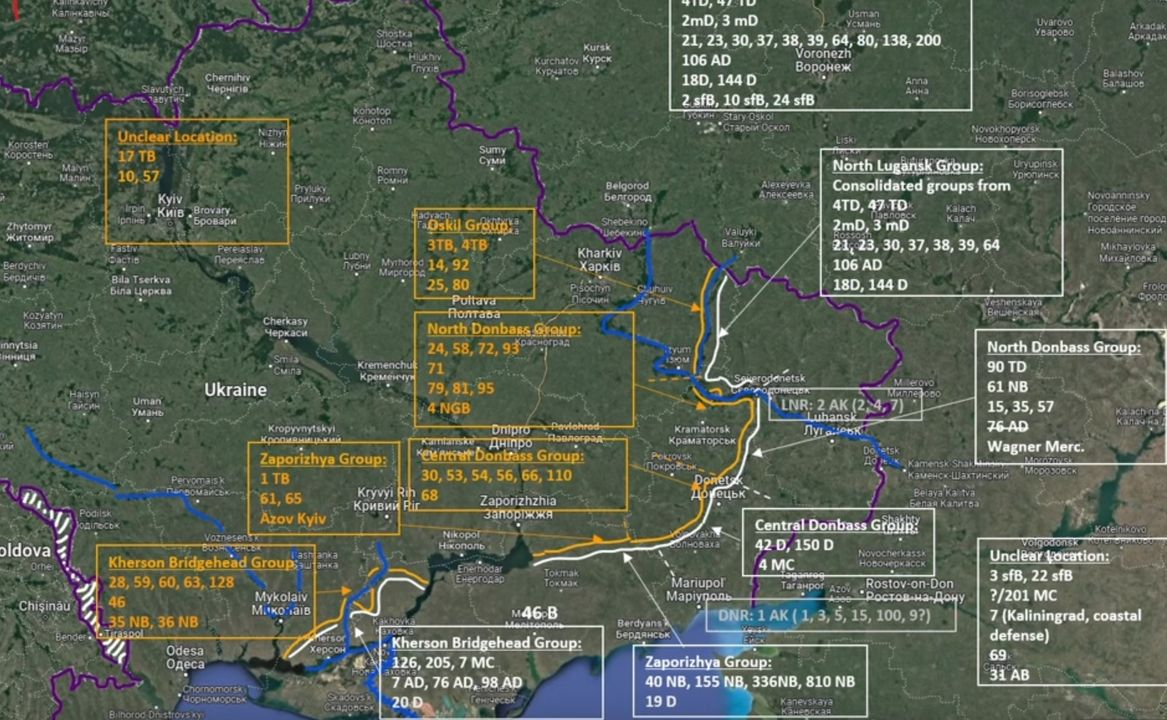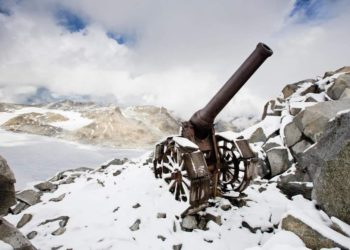Ukraine Update: Day 214

The situation on the ground for the past 6 days.
Stabilized Frontlines and Heavy Fighting
The frontline seems to have stabilized. The Ukrainians have retaken Bilohorivka, meaning the AFU is back in the Lughansk Oblast! Meanwhile, the Russians continue making incremental gains in the Donetsk Oblast around Bakhmut and elsewhere.
Heavy fighting was reported in Liman, Kreminna, and around Kupiansk. The Ukrainian army is trying to push across the Oskil and Siverskyi Donets rivers. Russian and separatist forces are trying to fight back in the Kreminna and Kupiansk areas.
Russian Losses During the Ukrainian Kharkiv Offensive
Ukrainian forces reported two weeks ago that they were being slowed down by the amount of Russian hardware left behind. Both sides like to boast and exaggerate, but for once, it seems there was an element of truth in the Ukrainian statement: Russian sources indicate the army left behind a very large amount of vehicles! Some were destroyed while fighting. As reported last Sunday, the odds were not in favor of the Russian side, with the Ukrainians enjoying an 8-1 numerical advantage in the province during their offensive. However, a Russian document published online by Russian sources indicates that much of the hardware left behind was serviceable. Said document shows that the Russians left 84 tanks behind, including 76 in working conditions! Also left behind were 165 APCs/IFVs and 59 artillery platforms. Some of those vehicles are pretty modern, too.
Those losses seem to explain why the Russian 1st Guards Tank Army was temporarily pulled back from the front and why we saw videos of T-90A MBTs being pulled out of storage in Russia a couple of weeks ago. In any case, it seems the 1GTA is back in Kharkiv just north of Severodonetsk.
Strikes and Shelling
Ukraine has hit Kherson, Donetsk, Nova Khakovka, and various targets in the Belgorod Oblasts. Russia accused Ukraine of having targeted the Zaporizhzhia Nuclear Power Plant, damaging water mains belonging to the cooling system in the process.
Russia has hit various targets in the Kharkiv Oblast, Kharkiv, Krivyi Rih, Bakhmut, and Kramatorsk.
Russia has launched strikes on Ukraine’s South Power Plant. Workshops and transformers on the perimeters of the power station were destroyed. Slavyansk’s Thermal Nuclear Power Plant was also hit and so was the Pecheneg dam in the Kharkiv region, which was attacked three days in a row, damaging the structure but not destroying it. The dam regulates the flow of the Siverskyi Donets river.
Notes on Attacks on National Electrical Power Systems
Following the initial Russian strikes on Ukrainian power stations, the internet was ablaze with condemnations, calling the acts “War Crimes.” So… Are strikes on the power grid war crimes?
The ICRC’s Article 56 of the 1977 Additional Protocol I states: “Works and installations containing dangerous forces, namely dams, dykes and nuclear electrical generating stations, shall not be made the object of attack, even where these objects are military objectives, if such attack may cause the release of dangerous forces and consequent severe losses among the civilian population”. Basically, destroying a large dam provoking a tsunami that would engulf whole towns downstream is not permitted. Similarly, a strike on a nuclear power station resulting in the release of large amounts of radiation, leading to large numbers of civilians becoming sick, would be forbidden.
In short, such attacks are not permitted if they inflict unnecessary and disproportionate suffering on large portions of the civilian population.
Historical Precedents of Attacks on Electrical Grids
Attacks on the electrical grid are permitted and are a regular occurrence on battlefields around the globe. USAF (Ret) Colonel John A. Warden is a big proponent of attacks on electrical grids: He developed the “Five Strategic Rings” theory in which such attacks are said to impact civilian morale, political leadership, military forces, and material production.
There is a good read on this subject on the JSTOR library, it is called “The law of non-combatant immunity and the targeting of national electrical power systems” by USN CDR (now Vice Adm.) James Walter Crawford III.
USAF Major Thomas E Griffith Jr. wrote an article in 1994 called “Strategic Attacks of National Electric Systems”. The article describes how the USAF planned to target the German and Japanese electrical grid during WWII but could not go ahead with it. It also describes how the US targeted and destroyed 90% of the North Korean grid between 1950 and 1953, 85%-90% of the Vietnamese grid between 1964 and 1973 and over 90% of the Iraqi grid in 1991. Major Griffith also analyses the effectiveness of such aerial campaigns versus expectations.
NATO forces (mainly UK and US planes) used BLU-114B graphite bombs in Serbia in May 1999, disabling 70% of the country’s power grid. Graphite bombs are “soft bombs”: they explode in air-bursts, covering everything in fine graphite dust, shorting exposed electrical circuits. Power can usually be restored when the circuits are cleaned up. However, in the late stages of “Operation Allied Force,” NATO’s air forces reverted to dropping conventional bombs on Serbian electrical infrastructure. Several French newspapers published articles covering this topic in May 1999. A NATO spokesperson at the time justified those strikes by saying they were destined to “increase psychological pressure on Yugoslav president Milosevic. Jamie Shea added “NATO has its finger on the Yugoslav electric grid’s power switch”.
Are strikes on the power grid war crimes? In short, no. Enemy electrical grid components have been natural targets for combatants as far back as WWI. Therefore, (strictly) technically speaking, the Ukrainian grid is fair game for Russia. Especially when one considers how reliant on railways the Ukrainian armed forces’ logistics are: The Ukrainian railways use 1627 electric locomotives and only 301 diesel ones. Cut power to the grid and one essentially paralyzes Ukrainian logistics. Furthermore, diesel is in short supply in the country, therefore, switching the logistics to roads and diesel-powered locomotives would rob a portion of available fuel away from frontline combat vehicles and vital systems such as air defense platforms, EW systems and so on.
Russian attacks on the Ukrainian grid are nothing new: Railway sub-stations were targeted for two weeks straight as far back as April. It is the targeting of Ukrainian power generation units (power stations) that is new. As such, those attacks indicate a Russian escalation in the conflict.
The targeting of small Ukrainian sluice gates and dams also indicates an escalation, although they represent minimal risks to the population. The targeting of structures within the perimeter of the South Power Station (nuclear) is, however, more problematic.
There is also a psychological impact to consider, both on the Ukrainian leadership and on the population: Winter is coming. Without electricity, there is no running water, no heating, and no internet/mobile communications. Just degrading the Ukrainian grid would force the Ukrainian authorities to choose where to direct available power: War effort or civilian population?
Again, we are not advocating such a strategy; we are trying to have a technical and logical conversation here.
State Duma Announcements and Implications
On the 20th of September, the Russian State Duma announced it would immediately amend or introduce new laws relative to concepts such as mobilization, martial law, war, voluntary surrender, looting, and desertion into the Russian criminal code. This prompted the world to wonder if Russia wasn’t about to announce an imminent mobilization.
The State Duma also announced that foreign volunteers would be allowed to serve within the Russian Armed Forces and adopted a resolution simplifying the acquisition of Russian citizenship by foreigners who have signed an annual contract for service in the Russian Armed Forces.
In short order during the day, Russian/separatist authorities of the Lugansk, Donetsk, Kherson, and Zaporizhzhia regions announced they would hold referenda on the Oblasts seceding from Ukraine and becoming subjects of the Russian Federation during the coming weekend (it started yesterday).
Then came the news that President Putin was about to address the nation. The speech was delayed several times before being rescheduled for the following morning so that “all regions of Russia could tune in and watch/listen together”.
Mobilisation Announcement by President Putin
Early in the morning of the 21st of September, President Putin announced a partial mobilization. The decree has already been signed. 300,000 Russian subjects are to be mobilized. Only people with prior military service will be recalled. The first to have received their draft papers were tankers, gunners, drivers, and mechanics. Privates and sergeants up to the age of 35 are eligible for the recall, while junior officers up to 50 years old and senior officers up to 55 years old are also eligible to be mobilized. Training that takes into account the lessons learned from the current conflict will be provided to mobilized personnel prior to deployment to the war zone.
Are not eligible: Students, conscripts, employees working for the defense industry, carers, unhealthy or disabled people as well as people in charge of families with more than 4 children under the age of 16. Mobilized personnel will receive the same pay and benefits as enlisted personnel.
The Russian Central Bank issued recommendations to Russian banks regarding mobilized personnel: They are to receive credit holidays for loans and mortgages and collection for overdue debts (as well as foreclosure procedures) must be suspended.
Interestingly, Moscow isn’t rushing into things: Conscripts are not to be mobilized. Russia processes around 260,000 conscripts a year and 130,000 of them are meant to cycle out of the army by the end of autumn, having finished their 1-year military formation. Those freshly trained conscripts would have been perfect for a fast surge at the front. Instead, Russia opted to mobilize reservists in need of training. As such, those men won’t be available for deployment before the end of the year/early 2023 at the earliest.
Consequences of Mobilization
It is expected that a fair portion of those reservists will end up in the rear areas and manning the logistic tail of the Russian armed forces in Ukraine, freeing combat personnel for offensive duties. Others, such as gunners and tankers, will obviously see combat duties.
Several protests erupted in Russia following the order to mobilize. Over 1,300 people were arrested during those protests. Many of them were subsequently issued with summons to the nearest military enlistment office. There are reports of Russian citizens trying to leave the country rather than going to the recruiter’s office. This is made easy by the fact Russia has so far kept its borders open. Maybe Moscow will have to take a leaf out of Kiev’s book: In Ukraine, most Ukrainian men aged 18 to 60 have been banned from leaving the country in anticipation that they may be called to fight (Washington Post, 9th of March 2022).
This Russian escalation will have consequences both on the battlefield and in the diplomatic arena. While the West and Ukraine have already announced they will not recognize the results of those “sham referenda,” the situation will unlock a fair few options for the Russian leadership: By more than doubling its manpower in Ukraine, the Russian military should be able to shore up the 1000km front it seeks to control more effectively.
More men will also be available for offensive operations, potentially enabling Russia to regain the initiative and push forward once more. But it is at the political and technical level that things will open up for the Russian leadership: Should the Donbass, Kherson, and Zaporizhzhia be integrated into the Russian Federation, from a strictly Russian legal point of view, Ukrainian soldiers operating in those areas would be classified as invaders, foreign servicemen on Russian soil. The decision to annex/integrate (pick your poison) those regions would administratively move Russian borders forward, turning the tables and de-facto showing Russia as being invaded. This would unlock the option for Moscow to change the nature of the hostilities (Currently labelled Special Military Operation – SMO) into something such as an anti-terrorist Operation (ATO) or even declare a state of war. This would – politically and administratively – make it easier to start additional rounds of mobilization.
Should Moscow manage to conquer the totality of the Donetsk, Kherson, and Zaporizhzhia regions, Russia would gain between 5 and 8 million new citizens across 108,000 square kilometers. That’s 1/5 of Ukraine’s total surface and roughly 21% of its population. This action would “downgrade” Ukraine into the 3rd largest European country below France. Losing Kherson alone would cost Ukraine 2 million hectares of prime agricultural land. Despite the war, the Kherson and Zaporizhzhia regions managed to harvest 2 million tons of grain, this year. The heavy industries of the Donbass (steel and coal) contributed to 16% of Ukraine’s GDP prior to the Maidan’s coup of 2014.
Military and Diplomatic Reactions
Following Russia’s intention to mobilize, online rumors abounded regarding Ukrainian military reserves being sent to the front from as far away as the Kiev and Odessa regions. This is unverified. However, Ukrainian reinforcements have been spotted near the Kharkiv, Donbass, and Zaporizhzhia fronts, especially near Liman.
Reactions and statements covering the 20th of September:
- Russian political analyst Alexander Dugin stated that “HIMARS hitting the Zaporizhzhia Nuclear Power Plant at the initiative of American informers could be interpreted by Russia as an attempted nuclear attack on the Federation”.
- “Attacks by Kiev after the announcement of the results of the referenda will be regarded as aggression against Russia” – Senator Olga Kovitidi.
- “Accession of new territories to Russia will be followed by political and military decisions to protect citizens living there…” – Chairman of the Russian State Parliament Control Committee Morozov.
- “Russian pseudo-referenda will wipe out any chance of ending conflict diplomatically”. -Ukrainian presidential office.
- “NATO will consider upcoming referenda in Kherson, Zaporozhzhia, Lugansk, and Donetsk regions on joining Russia as illegitimate”. – NATO Secretary General Jens Stoltenberg.
- “Referenda organized by Russia are an insult to principles of sovereignty and territorial integrity” – White House.
- “Referenda in Donbass, East Ukraine will not affect US support for Ukraine”. Pentagon.
- “Referenda that Russia will hold in Eastern Ukraine will never be accepted by Turkey”. President Erdogan.
- “France will not recognize results of Russian referenda, will carry on supplying weapons to Ukraine. However, Paris is ready to continue dialogue with Russia on Ukraine”. President Macron.
- Canadian prime minister Trudeau stated he does not recognize referenda in the “occupied regions of Ukraine”.
Reactions on the 21st of September
Reactions and statements covering the 21st of September:
- Ukrainian minister for the reintegration of uncontrolled territories Irina Vereshchuk said that Ukrainian citizens taking part in the Russian referenda could face up to 5 years in prison. Organizers could face up to 10 years.
- “Partial mobilization in Russia is wrong step”. – German vice-chancellor.
- The British Foreign Office “believes that statement by Putin on partial mobilization will lead to an escalation of the situation in Ukraine”.
- “Our position does not change because of the noise or any announcements somewhere”. – President Zelensky.
- After consultations between Minsk and Moscow, Belarus announced it would not mobilize.
- “After the Donbass region joins the Russian Federation, there can be no talk of negotiations with Ukraine”. – Russian parliament international affairs committee chairman Leonid Slutsky.
- “Decision to announce partial mobilization was made due to the fact that Russia is facing the military potential of the entirety of NATO and other unfriendly countries in Ukraine”. -Kremlin Spokesman Peskov.
- “EU is not at war with Russia but is helping Ukraine”. – EU external affairs representative Peter Stano.
- “We have never threatened Russia, we have never tried to encroach on its territorial integrity, but we will continue to support Kiev”. – UK Foreign Secretary James Cleverly.
- “We are not at war with Ukraine but with the collective West”. – Shoigu.
- Shoigu added that in Ukraine, Russia was faced with NATO logistics, intel gathering capabilities, command and hardware, as well as 70 military and 200 civilian satellites: “The Ukrainian army is completely under the control of Western countries. A fully Western command sits there”.
- “Moscow will take any signal by US to improve relations seriously but so far trend is opposite, with hybrid war is being waged against Russia. Its risks cannot be underestimated”. – Russian deputy foreign minister Ryabkov.
- “Putin’s decision to partially mobilize only spurs Berlin to give more support to Kiev”. – German defense minister Lambrecht.
- “China calls for resumption of direct dialogue between Russia and Ukraine”. – Chinese foreign minister.
- “US will continue to support Kiev as it defends itself, strengthening its position in order to reach diplomatic solution at negotiation table”. US Secretary of State Blinken.
- “European commission believes that Russia intends to erase Ukraine from the map of world, promise that EU will stand on side of Kiev”. Ursula von der Leyen.
Putin’s Address to the Nation
During his speech, president Putin said: “The West is seeking to weaken, divide and finally destroy this country, the West has been overtly stating that it managed to break up the Soviet Union back in 1991










